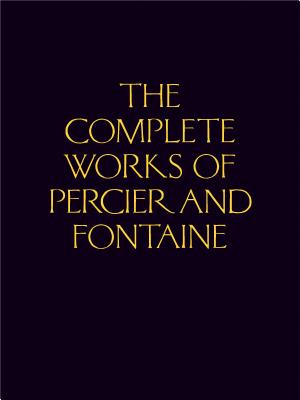You are here
Back to topThe Complete Works of Percier and Fontaine (Hardcover)
Email or call for price
Description
Known as "Napoleon's architects," Charles Percier (1764–1838) and Pierre Fontaine (1762-1853) were not only Emperor's official government architects, but two of the most celebrated teachers at the legendary Ecole des Beaux-Arts, responsible for developing the highly influential neoclassical Empire, or Directoire, style of design
In addition to their renovations to the Louvre and the Tuileries, and construction of the Arc de Tromphe de Carttousel, they are best known for Empress Josephine's house at Malmaison, where they effectively invented the profession of interior design by crafting every detail including all the furnishings. This book collects the entire printed output of these two important architects and archeologists of Roman architecture, four volumes condensed into one, and serves as the definitive edition on their work. The Collected Works of Percier and Fontaine is introduced by critic and historian Barry Bergdoll, and published in association with the Institute for Classical Art and Architecture.
About the Author
Charles Percier (1764–1838) and Pierre François Léonard Fontaine (1762–1853) were a highly influential pair of French architects and interior designers, credited with developing the neoclassical Empire style of design during the Napoleonic era.
Barry Bergdoll is Meyer Schapiro Professor of Art History and Archaeology at Columbia University. He served as Philip Johnson Chief Curator at the Museum of Modern Art from 2007 to 2013. He has published widely on modern architectural history, and art history.
Praise For…
"Three folio volumes and a final double folio (all dating from 1798 to 1838) are compressed here into a quarto with fine-grained detail intact. The volume is intended for historians, architects, and others involved in, or who enjoy, traditional design. The plans and elevations facilitate same-scale comparisons, and some oblique views offer insight. The book covers large and small post-antique palaces and churches in Rome and elsewhere in Italy, in France, and a few in Germany, Russia, and Spain. Percier and Fontaine are most noted as Napoleon's architects, and they created many precisely engraved interiors and furnishings for him and others of the era. Few survive today, so these original renderings are welcome. Also welcome are the complete original layouts of villas and urban complexes that have subsequently been mauled or truncated. Included are several colored plates, the original publications' information about the buildings, and a useful introduction by Barry Bergdoll (Columbia Univ.). The book joins the canonic three-volume Edifices de Rome moderne, by Percier's student Paul Letarouilly (1840; published in English translation by Princeton Architectural Press in 1984), which has more post-antique Roman buildings and more extensive details. Summing Up: Highly recommended. Upper-division undergraduates through faculty and professionals."
- Choice
"The substantial and definitive tome pulls together four separate volumes, reproducing the pair's entire written output along with numerous extravagant illustrations. While a full appreciation of the monograph text requires reading knowledge of French, their vibrant images offer universal appeal."- Architect's Newspaper
"This luxurious volume gathers together all of Percier and Fontaine's designs that were published between the years 1798 and 1812, while he was in the service of Napoleon, during the Consulate and Empire. The influence of the design-duo, who were responsible for many of Napoleon's palaces and public monuments as well as for the decorations and costumes for the "Sacre" in 1804 [Napoleon's consecration ceremony as Emperor], went far beyond the French Empire, explains Professor Barry Bergdoll (of Columbia University) in his introduction to the collection."
- Napleon.org
"The Complete Works of Percier and Fontaine encapsulates the team's particular genius, an aesthetic mode first known as style républicain but which became known as style Empire once it was adopted by Napoléon and his extended family. The appropriately imperial volume-gold lettering on a jet-black dust jacket-gathers together all Percier and Fontaine designs that were published between 1798 and 1812, engravings of tea tables, boiseries, friezes, beds, and ceilings that ravished Europe's sensibilities as swiftly as Napoléon's army invaded its countries..The 441-page book, part of Princeton Architectural Press's Classic Reprint Series and expertly scanned from originals, contains scores of engravings, beginning with Roman palaces and houses that the pair sketched on a youthful trip in the 1790s to a plan to revamp Paris's 17th-century Palais-Royal in 1829." - Architectural Digest Online

